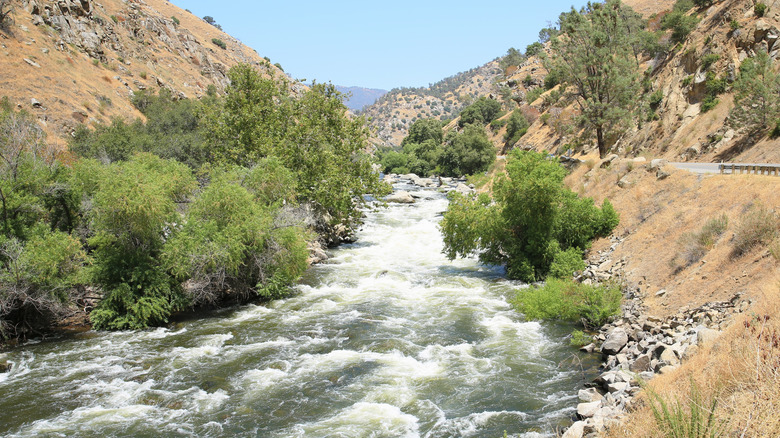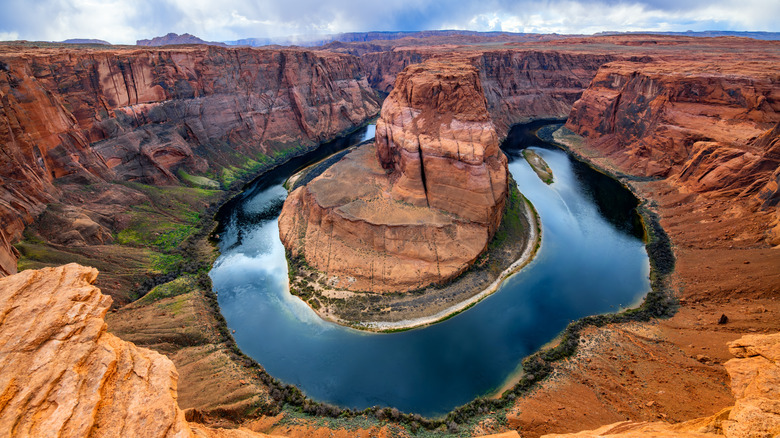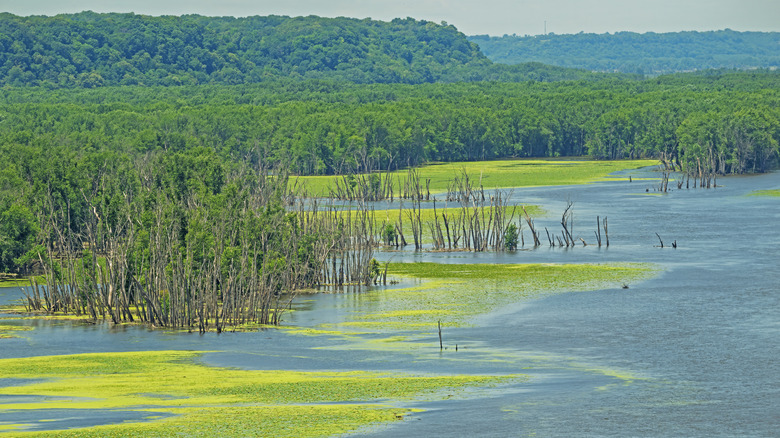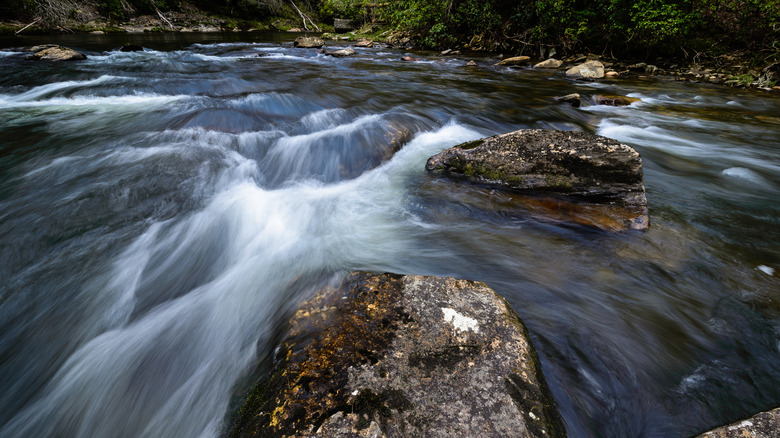The 5 Most Dangerous Rivers In America That Should Be Avoided At All Costs
America has some seriously wonderful rivers. From the mighty Mississippi, that majestic waterway known as 'America's River,' to the iconic Hudson, forever shrouded by the steel-clad skyscrapers of New York City, this nation is carved up by waterways large, small, and downright legendary. You've got some of the best rivers for kayaking on the continent, others that are steeped in Gold Rush history, and others still that promise hiking adventures amid rainforests and deserts.
The thing is, though, America also has some seriously dangerous rivers. These are great powers of nature — the Mississippi discharges more than half a million cubic feet of H2O every second, while certain famous sections of the Niagara River pound away with more than 2,500 tons of force (perhaps it's better to see the Niagara Falls from a zipline, after all!).
Now, there are no official stats for how many people have died on specific rivers across the country, but most of the estimated 11 daily drownings in the USA do occur in natural waters. To put it another way: Rivers can be very deadly. Finding the deadliest is tricky business (no official stats, remember?), but we've honed in on a variety of sources, from local police reports to press releases to mentions of particular rivers on expert forums, to offer up a selection of five that could certainly be candidates for the most dangerous of all.
Kern River
Two signs — one in English, one in Spanish — stand astride CA-178 as it leaves the flatlands of Cali's Central Valley and dips into the narrow Kern River Canyon. They're both emblazoned with a big red number that belies the darker side of this otherwise beautiful stretch of riverway in the southern Sierra Nevada. Over 300 deaths and counting. It's hardly a wonder that the Kern now has the spine-tingling moniker 'Killer Kern,' and an undisputed rep as one of the single deadliest rivers in the United States.
At 165 miles long, the Kern carves its way through parts of the Sequoia National Forest and the dreamy fall-foliage destination that is the Inyo National Forest from a source high up on the slopes of soaring Mount Whitney. It's divided into the Upper Kern and the Lower Kern, with the dividing line at the small town of Lake Isabela. The whole thing is a rafter's dream. The upper is home to roaring class V-rated rapids (that's the second most challenging rating of all), while the lower has slightly easier class III rapids to contend with.
Danger is never too far away on the Kern, though. For one, it's among the steepest rivers in the country, dropping over 70 feet over the course of just a mile. On top of that, the Kern River can see sudden upticks in current because it's fed by snowmelt in the high mountains. That means big drags in cold water along a riverbed that's peppered with boulders and jagged rocks.
Colorado River
There's hardly a more jaw-dropping river in the whole of America than the mighty Colorado. Birthed deep in the Rocky Mountains, the great, snaking waterway pushes south across the USA for nearly 1,500 miles. It's among the longest rivers in the country (the sixth longest to be exact), threading through a whopping seven states on its way to the bath-warm seas of Baja California over the Mexican border. And it's among the deadliest.
What's striking is that what seems to be the most dangerous section of the Colorado is also quite possibly its most spectacular. Cue the nigh on this 300-mile run of water that carves through Arizona's part of the legendary Grand Canyon. Here, the canyon walls soar to 4,000 feet above the river itself, gaping nearly 20 miles across at some points!
Reports show that 2024 proved to be particularly deadly. As many as eight people died in the area in just 42 days, making it one of the worst years on record. Of course, not all fatalities can be traced back to the Colorado River itself. There are plenty of other causes — helicopter accidents, falling from cliffs, and heatstroke. However, even a quick glance through NPS incident reports for the Grand Canyon is enough to show that drowning comes up time and time again.
Mississippi River
The mellifluous name of the Mississippi River often pops up on lists of the most dangerous waterways in the USA. Then again, this is the second-longest river in the whole dang country — it has a mind-boggling 2,350 miles of meanders to its name.
Just think on that fact for one moment: This river wiggles its way from its source in Minnesota all the way to the Gulf of Mexico in the south. As it goes, it passes right through the heart of major cityscapes like Saint Paul, St. Louis, and the Big Easy of New Orleans, not to mention countless smaller towns and settlements. The upshot? There's a whole load of river here, meaning plenty of places that could pose potential dangers.
True enough, reports of fatalities and accidents come thick and fast for the big old Mississippi. In 2025 alone, a trio of folks died while out fishing in Tennessee and another man was found dead from drowning in Minnesota. Alternatively, cast your research back even further and you'll find that the Mississippi is responsible for one of the worst disasters in US history: The Great Flood of 1927. That killed over 240 people across multiple states, and left 700,000 homeless to boot.
Potomac River
The National Park Service's official page on the Potomac River makes it very clear: Entering the water to swim or wade is 100%, totally illegal. The reason? This stretch is infamously peppered with whirlpools and undertows. It might look calm on the surface, but danger lurks below.
The Potomac noodles its way through the eastern states, from the foothills of Appalachia to the Atlantic Ocean, passing West Virginia, Maryland, and the bustling political power corridors of Washington, DC as it goes. According to the folk at Pond Informer, there's one section that you should be particularly wary of: The Great Falls of the Potomac.
The Great Falls form the centerpiece of an underrated state park just outside of the nation's capital. They're a tiered series of rock-ribbed boulders and ledges where the water whizzes through a gorge. Now, if that sounds a little sketchy, it's because it most certainly is! Just check the NPS incident reports, which chronicle everything from accidental slips to capsized kayaks over the course of the last 36 years.
Chattooga River
You may well have already seen the Chattooga River. It's featured as the backdrop for the goosebump-raising 1972 adventure thriller Deliverance, a cult hit movie about city boys lost in the American backcountry. You know it; it's the one with the banjo! The fictional river in the film proves to be a force to be reckoned with, something that's apparently all too true of the real-life Chattooga, too.
Yep, one thread on the r/whitewater Subreddit is titled, simply: "Deadliest Rapids?" The Chattooga gets namedropped not once, not twice, not even thrice, but a whopping five separate times. One user even sums up the riverway with the following line: "The Chattooga is dangerous. The undercuts are bad."
The official stats aren't good either. The US Forest Service counts nearly 40 fatalities on the river since 1970, and, despite updates and changes to safety regulations over the years, there continues to be an estimated one death per annum on its waters.
Our methodology
This isn't a list of the American rivers that have claimed the most lives overall. There's simply no central database that counts all the drowning deaths in various rivers across the USA. Instead, we've focused on picking the rivers that have a clear and well-documented case for danger.
To do that, we reviewed threads on the r/whitewater Subreddit, looked at listicles on the deadliest waters in America by industry-leading publications such as AOL, and sought out official national park and local sheriff safety warnings via NPS and local law enforcement websites. It's by no means an exhaustive look at all rivers in the country — the USA counts a whopping quarter of a million individual streams, creeks, and rivers. However, it should provide a credible snapshot of rivers that consistently appear in safety advisories and fatality reports.






